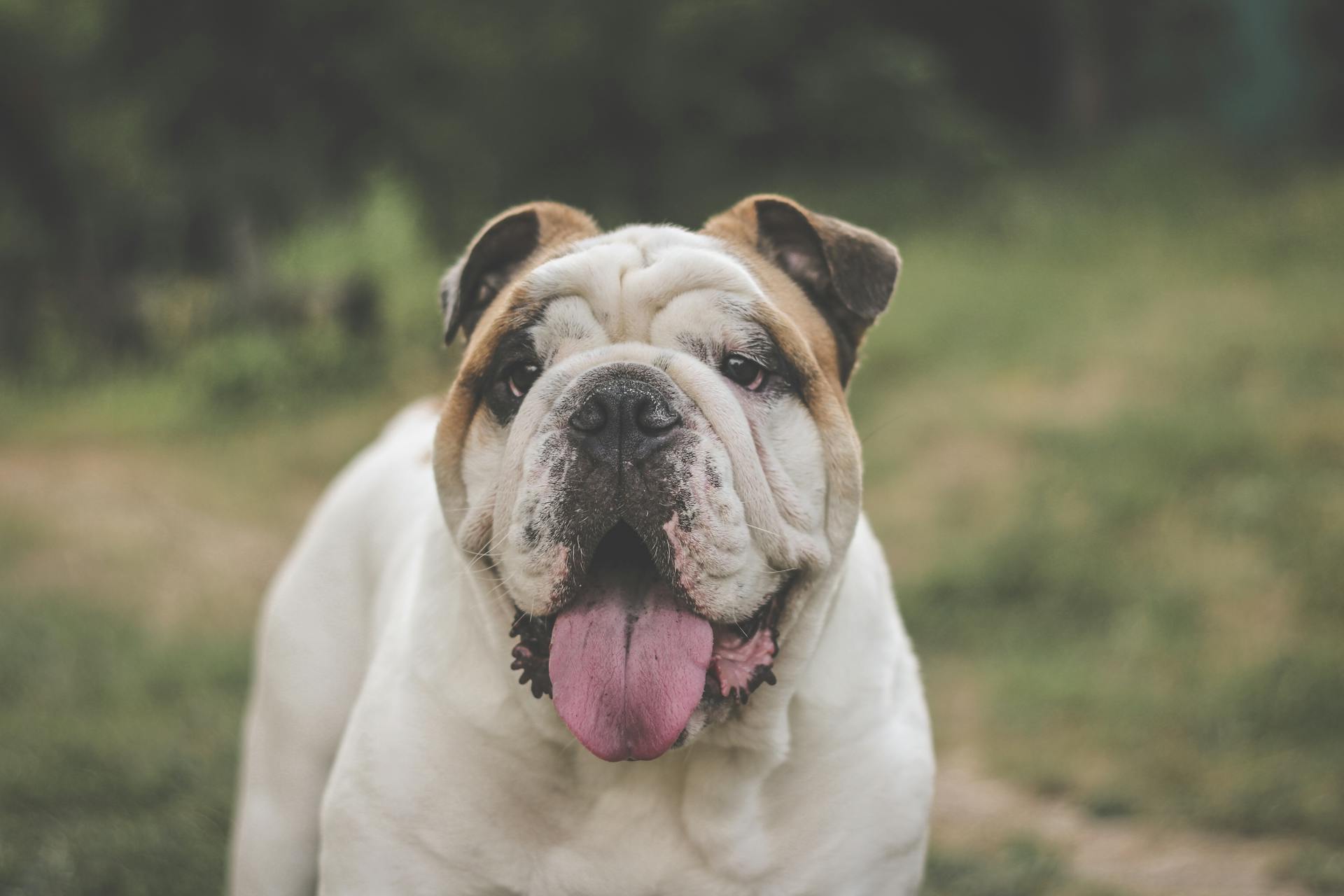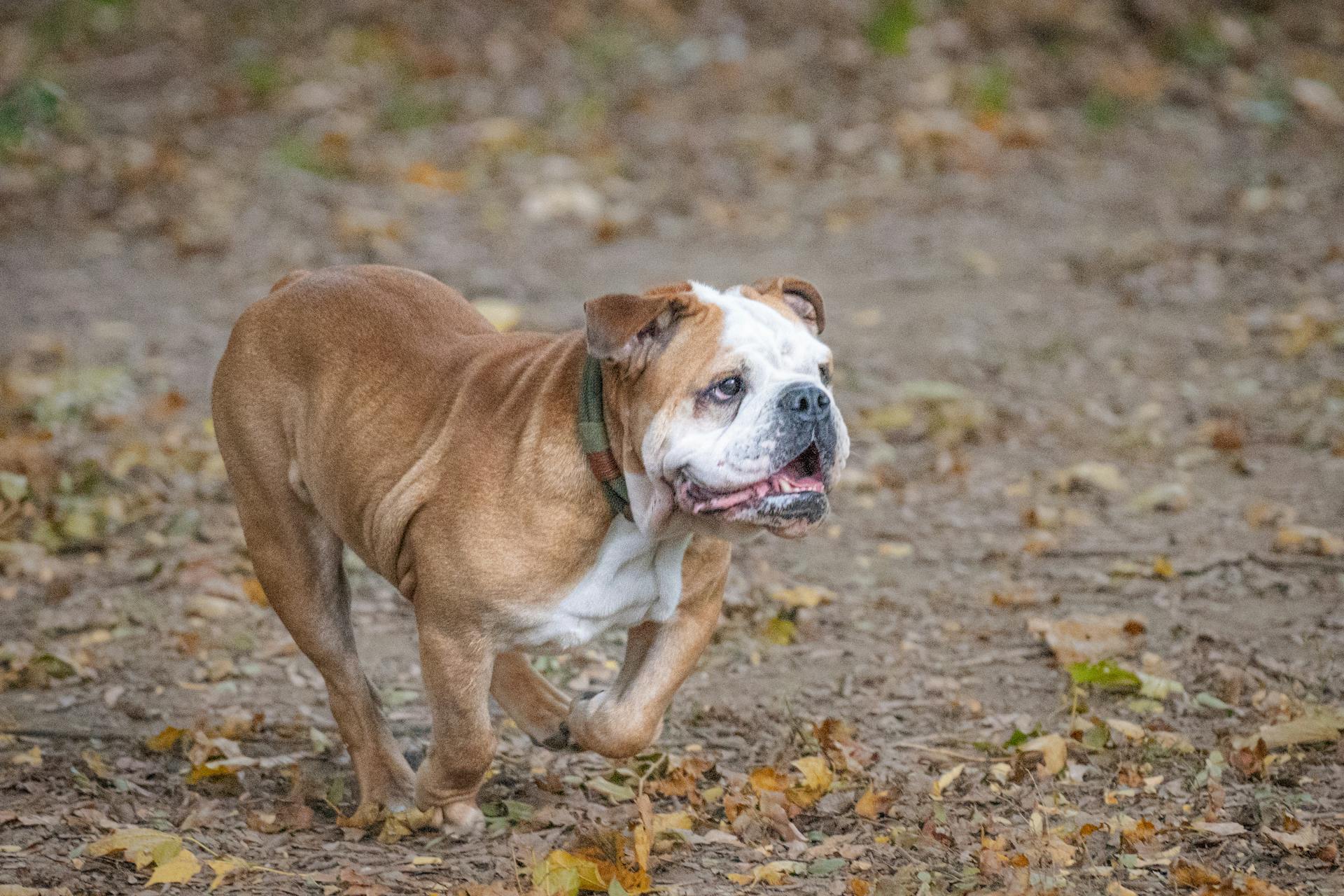
English Bulldogs are prone to eye infections due to their unique physical characteristics, such as their short, flat faces and protruding eyes.
Their eyes are more susceptible to dirt, dust, and other foreign particles, which can easily enter the eye and cause an infection.
English Bulldogs also have a tendency to develop cherry eye, a condition where the gland in the third eyelid becomes inflamed and protrudes from the eye.
This can lead to redness, swelling, and discharge in the eye, making it a common symptom of eye infections in English Bulldogs.
If this caught your attention, see: English Bulldog Red Eyes
Causes and Symptoms
English bulldog eye infections can be caused by various factors, including bacterial, viral, and fungal infections. Allergies, irritants, and trauma to the head or face can also lead to eye infections in English bulldogs.
Some common symptoms of eye infections in English bulldogs include redness, discharge, pawing at the eyes, swelling of the eyelid, and squinting. These symptoms can vary depending on the type and duration of the infection.
The most common causes of eye infections in English bulldogs include conjunctivitis, dry eye syndrome, and corneal abrasions. Corneal abrasions can be caused by trauma, such as a grain of sand entering the eye or a thorn cutting the cornea. Dry eye syndrome, also known as keratoconjunctivitis sicca, is a condition where the dog's eyes don't produce enough tears, leading to eye discharge and other symptoms.
Here are some common signs of a dog eye infection:
- Excess tearing
- Excessive winking or blinking
- Prolapse of the third eyelid
- Yellow-green discharge from the eye
- Pawing at the eye or keeping the eye closed
It's essential to take your English bulldog to the vet if you notice any of these symptoms, as prompt treatment can help prevent long-term damage to the eyes.
What Causes?
Dogs can develop red eyes due to various reasons, and it's essential to identify the cause to provide the right treatment. Allergies are one of the most common causes of red eye in dogs, triggered by allergens such as tree, grass, flower, and other pollens.
For another approach, see: Dogs Similar to English Bulldog

Some common irritants that can cause redness and inflammation in dog eyes include dust, sand, foxtails, and other foreign materials. These can get stuck in the eye or cause an allergic reaction, leading to redness and discharge.
Infections are another possible cause of red eye in dogs, and they can be caused by bacteria, viruses, fungus, or other microorganisms. Vaccinations and parasite preventative medications can help reduce the risk of eye infections.
Trauma to the head or face can also result in a red eye, such as from rough play with another dog or a scratch to the eye from a cat's claw. This type of trauma can cause inflammation and redness in the affected eye.
Dry eye is a condition where the dog's tear film is reduced, leading to redness and increased risk of corneal ulcers and eye infections.
Here are some common causes of eye discharge in dogs:
- Conjunctivitis (pink eye)
- Eye infections
- Allergies
- Corneal ulcers or other corneal injuries
- Dry eye (KCS)
- Glaucoma
- Entropion
- Ectropion
- Distichia
- Cherry eye
- Foreign object in the eye
- Growth on the eyelid or in the eye, such as a cyst or tumor
Causes of Discharge
Discharge from a dog's eye can be caused by a variety of factors. Conjunctivitis, or pink eye, is a common cause of discharge, but it's not the same as the human version. Dogs with conjunctivitis will often experience discharge, redness, and swelling, but these symptoms can also be caused by other conditions.

Allergies are another common cause of eye discharge in dogs. Pollen, dust, and other allergens can irritate the eyes and cause discharge. Irritants like dust, sand, and foreign materials can also cause inflammation and discharge.
Eye infections are a common cause of discharge, and they can be caused by bacteria, viruses, or fungi. Dry eye syndrome, also known as keratoconjunctivitis sicca, can cause discharge due to a lack of tears.
A list of common causes of eye discharge in dogs includes:
- Conjunctivitis
- Allergies
- Irritants
- Eye infections
- Dry eye syndrome
- Corneal ulcers or other corneal injuries
- Foreign object in the eye
- Growth on the eyelid or in the eye, such as a cyst or tumor
In some cases, discharge may be accompanied by other symptoms, such as redness, swelling, or squinting. If you notice any of these symptoms in your dog, it's a good idea to consult with a veterinarian to determine the underlying cause of the discharge.
Diagnosis and Treatment
A veterinarian will likely take a look at your English bulldog's eye and then decide from there what kinds of tests that they should do.
For bacterial eye infections, a culture of the eye discharge is likely needed.
Your veterinarian may prescribe topical antibiotics, oral antibiotics, and anti-inflammatory drugs to treat the infection.
In some cases, eye conditions in dogs are mistaken for eye infections, so your vet may run some more tests on your dog's eyes, such as the intraocular pressure test or eye drops that cause dilation of the eyes.
If your dog has a mild eye discharge, home treatment may be possible without a vet visit, but it's essential to consult with your vet before using any leftover eye drops or starting treatment.
If your dog is clearly in pain, showing other signs of eye issues, or the discharge returns soon after cleaning it, it's time to check in with your vet and formulate a second course of action.
Here's an interesting read: English Bulldog Hip Dysplasia Treatment
How Are Diagnosed
A veterinarian will likely take a look at your dog's eye and then decide from there what kinds of tests that they should do.
A bacterial eye infection will likely need a culture of the eye discharge, while an eye infection caused by allergies may not need much testing at all.
In some cases, eye conditions in dogs are mistaken for eye infections, so your vet will likely run some more tests on your dog's eyes.
The intraocular pressure test tests for glaucoma, and eye drops can allow vets to look for other abnormalities in the eyes.
Eye conditions like glaucoma are not really eye infections, but they're often mistaken for them because they can appear similar symptom-wise.
Worth a look: Staph Infection English Bulldog Skin Conditions Pictures
Treatment
Topical antibiotics are warranted for corneal ulceration, and the choice of antibiotic will depend on the severity. If you suspect your dog has a corneal ulceration, take them to a veterinarian right away.
Artificial tears will help with dry eye symptoms, but only when given three to four times daily. They won't provide the long-term solution your dog needs.
A veterinarian-prescribed tear stimulant will promote natural tearing and provide the long-term solution your dog needs. This is especially important for dogs with chronic dry eye.
Oral antibiotics and anti-inflammatory drugs will be prescribed by a veterinarian for eyelid infections. This is because eyelid infections can be more serious than they initially seem.
Your veterinarian will take a history of symptoms and conduct a comprehensive eye exam for diagnosis and prescription of appropriate treatment. This goes beyond looking at the eye with instruments.
If you try to treat your dog's eye infection on your own, you may make the condition worse. Don't attempt to use human medications or medications previously prescribed to your dog.
Give your dog the medication as prescribed by your veterinarian, whether that be administering eye drops or oral medication. This will give your dog the best chance to recover with minimal complications.
You can use a cotton ball saturated in lukewarm water to gently rinse your dog's eye until you can get to the vet or emergency vet. This can help reduce discomfort and prevent further trauma.
You might like: English Bulldog Vet

Mild eye discharge may be managed at home without a visit to the veterinarian. Home treatment includes wiping with a tissue or damp cloth, and using OTC drops such as contact solution.
If using drops, make sure not to touch the tip of the bottle to the eye to prevent contamination. This is especially important when using OTC drops on your dog's eyes.
If your dog is clearly in pain, showing other signs of eye issues, or the discharge returns soon after cleaning it, it's time to check in with your vet. This will help you and your vet formulate a second course of action.
Your veterinarian may prescribe medicated eye drops or ointment to treat the eye condition. In some cases, oral medications may also be prescribed.
Eye infections in dogs are treated differently depending on the type of eye infection it is and what is causing it. Bacterial eye infections are normally treated with antibiotics.
Additional reading: English Bulldog Skin Allergies Home Remedies
Symptoms and Types
English bulldogs can be prone to eye infections due to their unique facial structure and skin folds. Redness is a common symptom, with their eyes appearing pinker or redder than normal.
Increased discharge or "eye boogers" from one or both eyes is another sign, especially if it's thicker than normal, colored, or excessive. Eye infections can be itchy or painful, causing your bulldog to paw at their eyes or drag their face across surfaces.
Swelling of the eyelid can occur, resulting in a swollen or droopy-looking eyelid. Irritation or pain can cause squinting or increased blinking of the infected eye(s).
Here are some common symptoms of eye infections in dogs:
- Pawing or itching at the eyes
- Discharge coming from the eye
- A pink or red looking eye
- Eye swollen shut or more mild swelling around the eye
- Excessive blinking
- Light sensitivity
- Squinting
- Changes in the eye’s appearance
- Signs of pain
- Sudden poor vision
There are several types of eye infections in dogs, including conjunctivitis, uveitis, problems with the cornea, and infection of the eyelids or tear glands. These types can present differently, but common symptoms include redness, discharge, and swelling.
Explore further: English Bulldog Tail Types
Early cherry eye in dogs can be identified by a fleshy pink swelling at the corner of the eye, typically near the nose. This condition can lead to dry eye and infections if left untreated.
Recent eye infections can exhibit symptoms such as excess tearing, excessive winking or blinking, prolapse of the third eyelid, yellow-green discharge, and pawing at the eye.
Conjunctivitis and Cherry Eye
Conjunctivitis is a common eye infection in dogs, including English Bulldogs. It's characterized by a pink or red appearance in the eye, accompanied by discharge that may be foul-smelling.
The condition is often caused by a bacterial infection, but allergies and viral infections can also be responsible.
Cherry eye, on the other hand, is a condition where the gland within the third eyelid becomes inflamed and sticks out onto the surface of the eye. It's a genetic predisposition that affects some breeds, including English Bulldogs.
Early-stage cherry eye is usually painless and may not even be noticed by the dog. However, it can lead to dry eye and infections if left untreated.
Curious to learn more? Check out: English Bulldog Cherry Eye
Some common causes of red eye in dogs include allergies, irritants, infection, trauma, and dry eye. Conjunctivitis and cherry eye are two of the most common conditions that can cause red eye.
Here are some breeds that are prone to cherry eye:
- English Bulldogs
- Cocker Spaniels
- Cane Corsos
- Basset Hounds
- Beagles
- Boxers
- Boston Terriers
- French Bulldogs
- Rottweilers
- Saint Bernards
- Pugs
- Mastiffs
- Terrier breeds
If you notice any signs of conjunctivitis or cherry eye in your English Bulldog, such as redness, discharge, or a bulge in the corner of the eye, it's essential to consult with a veterinarian promptly.
Frequently Asked Questions
How do I treat my dog's eye infection at home?
To treat your dog's eye infection at home, rinse the affected area with a saline solution and gently wipe away discharge with a damp cotton ball. You can purchase saline solution or make your own with salt water to help soothe and clean your dog's eye.
Do dog eye infections heal on their own?
No, dog eye infections typically require immediate veterinary attention and do not heal on their own. Untreated infections can lead to blindness and severe pain.
Sources
- https://www.akc.org/expert-advice/health/dog-eye-infections/
- https://www.zoetispetcare.com/blog/article/treat-eye-infections-dogs
- https://www.dailypaws.com/dogs-puppies/health-care/dog-conditions/dog-eye-discharge
- https://pvecvets.com/blog/dog-eye-infection-symptoms-and-treatment/
- https://www.dailypaws.com/cherry-eye-in-dogs-7492190
Featured Images: pexels.com


